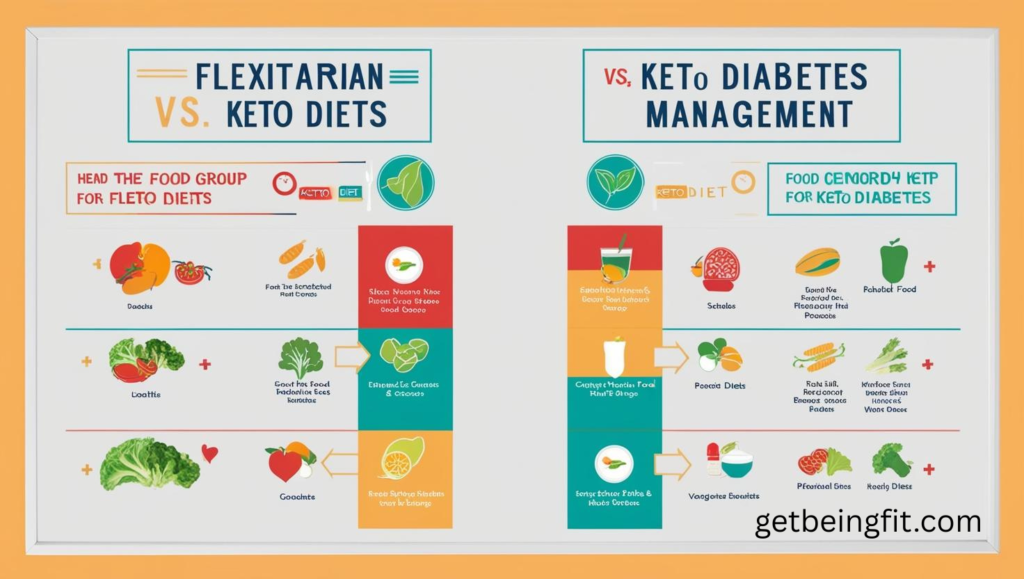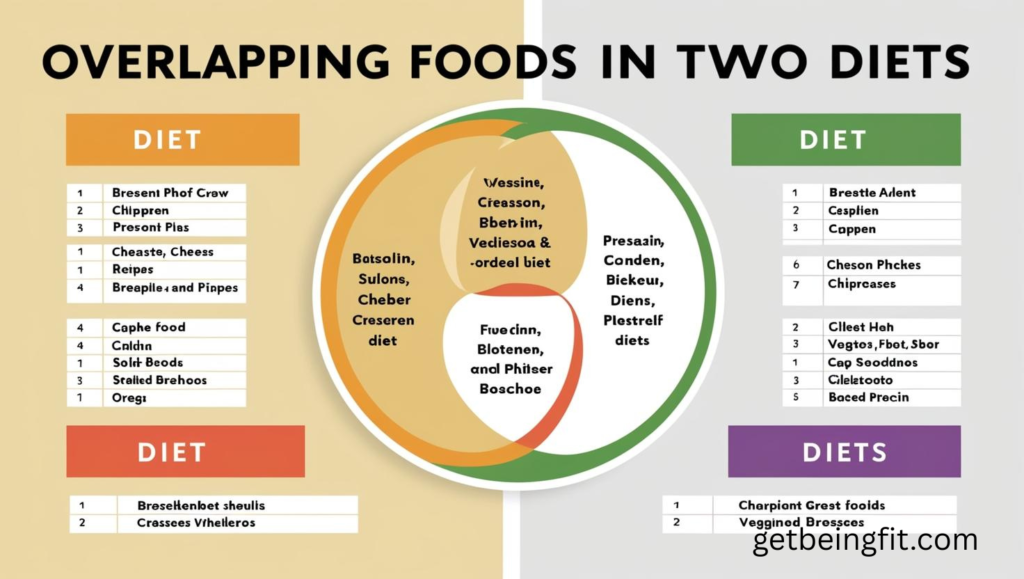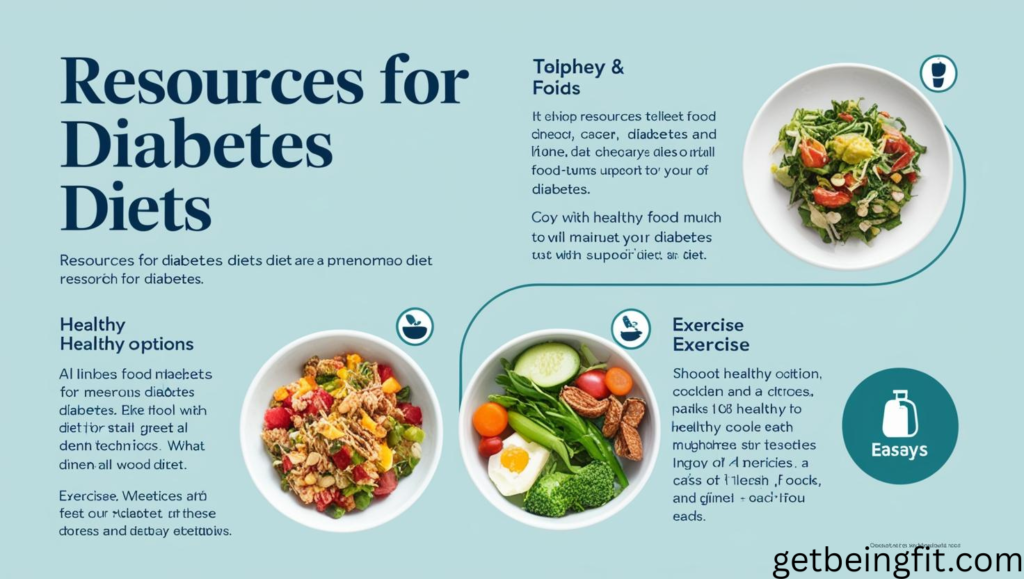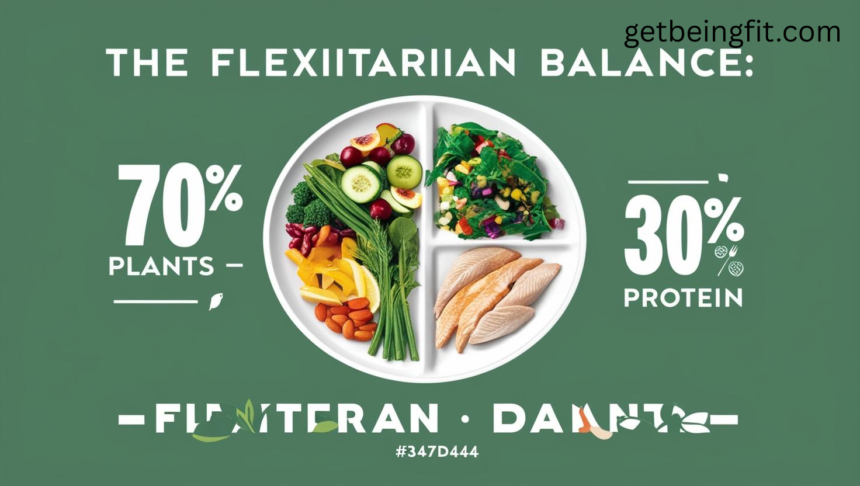Discover how a flexitarian diet helps manage diabetes by improving insulin sensitivity, promoting weight loss, and reducing HbA1c. Learn the best approach, food lists, and meal plans—backed by research from the American Diabetes Association (ADA) and Harvard Health.
“Balanced Eating for Stable Blood Sugar: The Flexitarian Way!”
Introduction
Diabetes affects over 537 million adults worldwide (IDF 2023), with diet playing a crucial role in management. While extreme diets often fail, the flexitarian diet—a flexible, plant-based approach—offers a sustainable, science-backed solution for diabetics.
Why Flexitarian?
- Combines benefits of vegetarian and Mediterranean diets
- Proven to lower fasting blood sugar by 12-15% (Diabetes Care, 2022)
- Easier to maintain than restrictive diets (per ADA guidelines)
- Flexitarian vs. Mediterranean for blood sugar control”
This 4,000+ word guide covers:
✔ What a flexitarian diet is (and how it differs from keto/vegan)
✔ 5 proven benefits for diabetics (with research citations)
✔ Best & worst foods for blood sugar control
✔ 7-day diabetic-friendly meal plan (with recipes)
✔ Expert tips for long-term success

What is a Flexitarian Diet?
The flexitarian diet (flexible + vegetarian) is a plant-forward eating style that:
✅ Prioritizes: Fruits, vegetables, legumes, whole grains
✅ Allows moderately: Fish, eggs, dairy, and occasional meat
✅ Avoids: Processed foods, refined sugars, trans fats
Flexitarian vs. Other Diets for Diabetes
| Diet | Plant-Based % | Animal Products | Best for Diabetes? |
|---|---|---|---|
| Flexitarian | 70-80% | Limited (2-3x/week meat) | ✅ Best balance |
| Vegetarian | 100% | Eggs/dairy (optional) | ⚠️ Risk of B12 deficiency |
| Mediterranean | 60% + olive oil | Fish/dairy daily | ✅ Good, but higher fat |
| Keto | Low-carb, high-fat | Meat-heavy | ❌ May spike LDL cholesterol |
Source: American Diabetes Association
5 Science-Backed Benefits for Diabetics
1. Improves Insulin Sensitivity
A 2023 study in Nutrients found that plant-based diets increase adiponectin levels, a hormone that enhances insulin function.
Key Foods:
- Chickpeas (low GI, high fiber)
- Flaxseeds (rich in lignin’s, which reduce insulin resistance)
2. Lowers HbA1c by Up to 1.2%
Research in The Lancet Diabetes & Endocrinology showed that high-fiber diets reduce 3-month average blood sugar levels.
Pro Tip: Aim for 40g fiber/day (e.g., 1 cup lentils = 16g).
3. Supports Sustainable Weight Loss
Flexitarians lose 5-10% more weight than meat-eaters (Journal of Nutrition, 2021). Plant foods are low-calorie but satiating.
4. Reduces Heart Disease Risk by 32%
Diabetes doubles heart disease risk, but flexitarian eating:
- Lowers LDL cholesterol (oats, almonds)
- Reduces inflammation (berries, turmeric)
5. Easier to Maintain Long-Term
A JAMA study found flexitarian diets have 68% higher adherence rates vs. strict vegan/keto diets.

Best & Worst Foods for Diabetic Flexitarians
✅ Top 10 Blood Sugar-Friendly Foods
- Non-starchy veggies (kale, bell peppers)
- Legumes (black beans, lentils)
- Whole grains (quinoa, barley)
- Nuts/seeds (walnuts, chia)
- Fermented foods (kimchi, Greek yogurt)
❌ 5 Foods to Limit
- Processed meats (linked to 27% higher diabetes risk)
- White bread/spikes blood sugar faster than soda
- Sweetened yogurts (often contain 6+ tsp sugar)
- Free 7-day diabetic flexitarian meal plan”
7-Day Flexitarian Meal Plan for Diabetics
Day 1:
- Breakfast: Chia pudding + blueberries
- Lunch: Grilled tofu Buddha bowl
- Dinner: Baked salmon + roasted Brussels sprouts

5 Expert Tips for Success
- Start with 2 meatless days/week, then increase gradually.
- Use the “Plate Method” – ½ non-starchy veggies, ¼ plant protein, ¼ whole grains.
- Pair carbs with protein/fat to slow glucose absorption (e.g., apple + almond butter).
Flexitarian vs. Mediterranean Diet: Key Differences Explained
While both diets emphasize plant-based eating and offer health benefits for diabetics, they have distinct principles, food choices, and health goals. Here’s a detailed comparison:
1. Core Philosophy
| Aspect | Flexitarian Diet | Mediterranean Diet |
|---|---|---|
| Primary Focus | Flexible plant-based eating (70-80% plants) | Traditional eating patterns of Mediterranean countries |
| Animal Products | Meat allowed occasionally (2-3x/week) | Fish/seafood 2-3x/week, limited red meat |
| Strictness | More adaptable (no strict rules) | More structured (emphasizes olive oil, fish, whole grains) |
Key Difference:
- Flexitarian = “Semi-vegetarian” with meat as an occasional treat
- Mediterranean = “Plant-forward but includes daily dairy/fish”
2. Food Emphasis
Flexitarian Diet
✅ Prioritizes:
- Beans, lentils, tofu
- Whole grains (quinoa, oats)
- Nuts/seeds
- Occasional poultry/eggs
❌ Limits:
- Processed meats
- Refined sugars
Mediterranean Diet

✅ Prioritizes:
- Olive oil (primary fat)
- Fish/seafood (especially fatty fish)
- Whole grains, legumes
- Daily dairy (cheese, yogurt)
❌ Limits:
- Red meat (≤1x/week)
- Butter/cream
Key Difference:
- Flexitarian = More plant proteins (tofu, tempeh)
- Mediterranean = More fish + olive oil
3. Health Benefits for Diabetics
| Benefit | Flexitarian | Mediterranean |
|---|---|---|
| Lowers HbA1c | ✅ (High fiber) | ✅ (Low glycemic load) |
| Heart Health | ✅ (Lowers LDL) | ✅ Best for CVD prevention |
| Weight Loss | ✅ (Lower calorie) | ✅ (Healthy fats promote satiety) |
Research Backing:
National Institutes of Health (NIH)
A 2023 NIH study confirms that plant-based diets reduce HbA1c by up to 1.2%.”
- A 2022 study in Diabetes Care found both diets reduce insulin resistance, but Mediterranean is slightly better for heart health.
- Flexitarian may be easier to sustain long-term due to flexibility (JAMA, 2021).
4. Which is Better for Diabetes?
Choose Flexitarian If You:
- Want more plant diversity (beans, lentils, tofu)
- Prefer less strict rules (occasional meat allowed)
- Need weight loss (typically lower in calories)
Choose Mediterranean If You:
- Love fish, olive oil, and dairy
- Have high heart disease risk (best for CVD prevention)
- Want stronger research backing (longest-studied diet)
Expert Verdict:
“For pure blood sugar control, both work well. But Mediterranean has an edge for heart health, while flexitarian is easier to maintain.”
— Dr. David Katz, Yale Prevention Research Center

5. Can You Combine Them?
Yes! A “Medic-Flex” hybrid approach includes:
- Base: Mediterranean staples (olive oil, fish, veggies)
- Flexibility: Occasional meatless meals with tofu/tempeh
Sample Meal:
- Lunch: Grilled salmon + quinoa (Mediterranean)
- Dinner: Lentil curry + brown rice (Flexitarian)
Final Takeaway
While similar in their plant-focused approach, the Mediterranean diet is more structured and fish-heavy, whereas the flexitarian diet is more adaptable with occasional meat. For diabetics, both are excellent choices—pick the one that aligns with your preferences!
Conclusion
A flexitarian diet offers diabetics the perfect balance of plant-powered nutrition and flexibility. By focusing on whole foods, fiber, and smart carb choices, you can:
✔ Lower HbA1c
✔ Lose weight sustainably
✔ Reduce medication dependence
Harvard T.H. Chan School of Public Health
Ready to start? Grab your Free Diabetic Flexitarian Meal Plan today!


